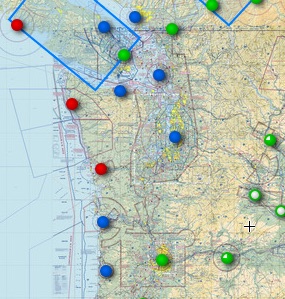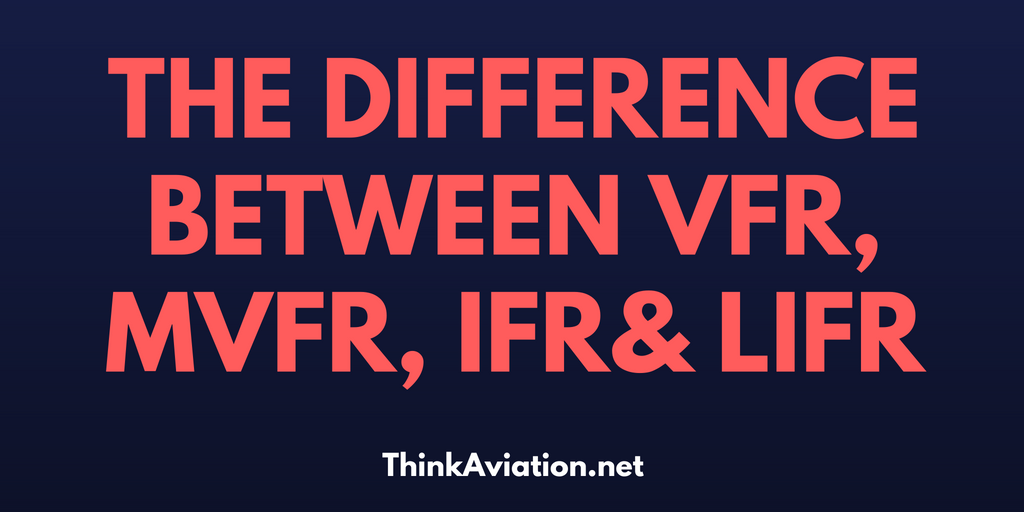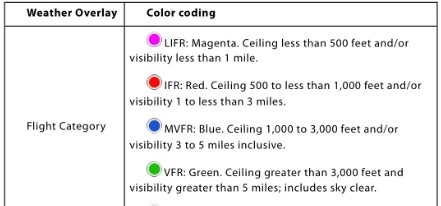What do all those different colored dots mean when I get weather? Great question. The better question, though, is should I fly when I see a blue, red or magenta dot?
Knowing the difference between these colors and categories will let you quickly determine whether it is a good day to fly.
So, what are the differences between LIFR, IFR, MVFR, and VFR and how can you use that knowledge to steer clear of dangerous conditions?
The basics:
1. Low Instrument Flight Rules (LIFR): Ceilings are less than 500 feet above ground level and/or visibility is less than 1 mile.
LIFR = <500′ and/or <1 mile
In other words, even experienced IFR pilots may have a hard time landing. With these conditions, they’ll break out just above the standard minimums for an ILS approach (200-1/2)
LIFR is depicted in Magenta on flight planning software such as Skyvector.com and Foreflight.
2. Instrument Flight Rules (IFR): Ceilings 500 to less than 1,000 feet and/or visibility 1 to less than 3 miles.
IFR = 500-1000′ and/or 1-3 miles
In other words, you must be on an IFR Flight plan or request Special VFR clearance from tower.
IFR is depicted in Red on flight planning software.
Note: VFR pilots can’t do Special VFR at night unless they are Instrument rated. To read more on Special VFR clearances, click here.
3. Marginal VFR (MVFR): Ceilings 1,000 to 3,000 feet and/or visibility is 3-5 miles inclusive.
MVFR = 1000-3000′ and/or 3-5 miles
This is when VFR pilots kill themselves all the time. If you haven’t flown in MVFR, ask a CFII to take you up so you can scare the sh@*t out of yourself.
MVFR is depicted in Blue on flight planning software
Remember, METARs only cover within 5NM of the airport. You have no idea what will happen the farther you get out. This is especially true in mountainous terrain.
You also need to maintain VFR cloud clearance in Class E airspace which starts at 700 or 1200 feet AGL. So if the cloud bases are at 2000 feet you have to fly at 1500 feet. No matter what the terrain is doing you have to stay 500 feet below the clouds so you can avoid descending IFR traffic.
Do you see where this can get back really quickly?
If you don’t have an instrument rating, you should seriously consider staying home when the conditions are MVFR.
If you have an instrument rating, file IFR! Don’t scud run!
4. VFR: Ceiling greater than 3000 feet and visibility greater than 5 miles (includes sky clear).
VFR = >3000′ and >5 miles
VFR is depicted in Green. If you see green dots, that’s great! Go fly! (unless the winds are too strong, or there are convective SIGMETs….)
Practical application:
Okay, so now you know the basics, let’s see how this information will make a go/no-go decision quick and easy.
Check out this picture from Skyvector.com of the Pacific Northwest on Thursday, Nov. 12th, 2015.

The three red dots on the coast indicate IFR conditions. The multiple blue dots show some Marginal VFR conditions and the green shows VFR.
Notice how quickly you can make a decision on where to fly?
Now check out the next image. This image shows the same dots but layered with the radar image (green is rain).
Yes…I know…it’s raining in Seattle…
The dots are a great way to capture an overall picture of your flight route. I recommend you always bring up this picture during flight planning.
Note: These are static pictures, so be careful. You should always look at looping radar to see where the winds are pushing the clouds.
Also, don’t take it for granted that a green dot means no clouds. If you look at the picture above, that’s not the case.
To wrap it up here is an image from Foreflight explaining what the dot colors mean:
Additional reading:
Weather Flying by Robert N Buck and Robert O Buck
If you are reading this article you probably want to know more about aviation weather. If that’s the case, you must pick up a copy of Weather Flying.
This is the most comprehensive book on aviation weather ever written.
The best part is it’s easy to read.
I know what you’re thinking…a book on weather that’s enjoyable to read? I’m serious. Every time I pick up this book I think: “This book is awesome!”
Pick up your copy now. I recommend the hardcover version because it’s one of those rare books that belongs in hardcover.
Hey! One more thing!
Do you struggle with NOTAMs? Pick up a free PDF on how to decode NOTAMs below.


